Abstract
The use of printed spiral coils (PSCs) as inductors in the construction of Wireless Power Transmission (WPT) circuits can save space and be integrated with other circuit boards. The challenges and issues of PSCs present for WPT mainly relate to maintaining an inductive characteristic at frequencies in Ultra High Frequency (UHF) band and to maximising the power transfer efficiency (PTE) between primary and secondary circuits. A new technique is proposed to increase the Q-factor relative to that offered by the PSC, which is shown to enhance WPT performance. This paper provides four-turn planar split-ring loops with high Q-factor for wireless power transmission at UHF bands. This design enhances the power transfer efficiency more than 12 times and allows for a greater transfer distance from 5 mm to 20 mm, compared with a conventional planar rectangular spiral coil.
1. Introduction
With the continuous progress in science and technology, a myriad of implantable medical devices (IMDs) have been invented and aimed at improving public health and wellbeing [1,2,3]. One of the main problems with these devices is their limited battery lifetime. This results in otherwise unnecessary surgeries to replace depleted batteries leading to excessive medical expenses. Wireless Power Transmission (WPT) technology represents an option that would allow a patient to avoid the need for additional surgeries to replace batteries, and hence avoid the obvious associated health risks, economic burden and patient inconvenience [4].
WPT technology can be mainly divided into two categories: far-field WPT (radiative) and near-field WPT (non-radiative). To be specific, far-field WPT can be sorted into directive radio frequency (RF) power beamforming and non-directive RF power beamforming [5,6]. Near-field WPT can be classified into a further three approaches, namely, inductive coupling [7], magnetic resonance coupling [8] and capacitive coupling [9]. Generally, far-field WPT is used in applications such as ambient energy harvesting and low-power wireless sensors as it can achieve power transmission over a range of several metres to kilometres. Near-field WPT has wider application possibilities, such as electric vehicles, wearable/implantable electronic devices, mobile phones and laptops. Inductive coupling is based on electromagnetic induction between two coils. Magnetic resonance coupling (MRC) is based on electromagnetic resonance between two resonators with the same resonance frequency. Capacitive coupling delivers energy via electric fields formed between metal plates. Inductive coupling requires accurate alignment. Magnetic resonance coupling can have a relatively large transfer distance with high power transfer efficiency. Capacitive coupling is suitable for those applications where the transfer distance is less than 1 mm. A fully planar wireless power link based on the MRC method is proposed in [10] at an operating frequency of 13.56 MHz using square printed spiral coils (PSCs). The dimension of the primary coil is 65.5 mm × 65.5 mm and the dimension of secondary coil is 20.5 mm × 20.5 mm. The separation between primary coil and secondary coil is 10 mm. The measured power transfer efficiency (PTE) was 79.8%. The use of coplanar PSCs with the dimension of 50 mm × 50 mm for WPT operating at 13.56 MHz in [11] can achieve 81.68% of PTE at a distance of 10 cm. A compact planar WPT link using printed spiral resonators is presented in [12]. The measured PTE of this proposed WPT link with the separation of 100 mm can reach 31.56% at 50.25 MHz. The dimension of proposed printed spiral resonators is 120 mm × 120 mm. A PSC with the dimension of 80 mm×80 mm as the transmitting coil and a receiving PSC with the dimension of 20 mm × 20 mm are used for WPT at 13.56 MHz [13]. When the distance between the transmitting coil and the receiving coil is 30 mm, the measured PTE of 77.9% can be obtained.
A conventional rectangular planar spiral coil (PSC) operating in the sub-GHz region was utilized in a wireless power transfer (WPT) system [14]. Simulations showed that this type of coil could only provide a low power transfer efficiency (PTE) and operate over a short transfer distance due to its low inductance and small magnetic field area. To improve the PTE capability of these coils, one option is to increase the coil Q-factor by minimising the resistive effects [15,16,17]. Increases in transfer distance could be achieved by enlarging the coil and hence the area of the magnetic field. The novelty of this work is to propose a four-turn planar split-ring loop to obtain a very high Q-factor at ultra-high frequency band, which can significantly enhance power transfer efficiency and transfer distance of WPT link by using two planar split-ring loops. The design principle of planar split-ring loops is illustrated in Section 2. The performance of the WPT link using two identical planar split-ring loops is provided in Section 3. Section 4 offers the measured power transfer efficiency of this proposed WPT link. Conclusions are highlighted in Section 5.
2. Principle of Planar Split-Ring Loops
2.1. A Conventional Rectangular Planar Spiral Coil
The geometrical parameters of a rectangular planar spiral coil printed [14] on FR-4 substrate (εr = 4.4) are shown in Figure 1. The final values of the parameters are listed in Table 1. This rectangular PSC was printed on FR-4 substrate with a size of 20 mm × 18 mm × 1.5 mm. The trends of inductance, resistance and Q-factor of the optimised rectangular PSC are shown in Figure 2 and Figure 3. The inductance, parasitic resistance and Q-factor of the optimised rectangular PSC at 403 MHz are 106 nH, 1.91 Ω and 140, respectively.
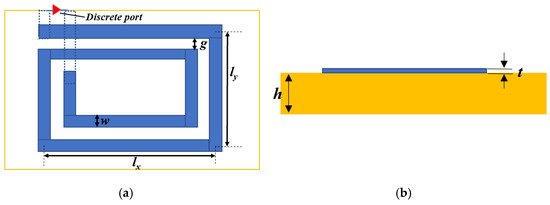
Figure 1.
Geometrical parameters of a rectangular PSC on the substrate (a) Top view (b) Side view.

Table 1.
Final parameter vales of a rectangular PSC.
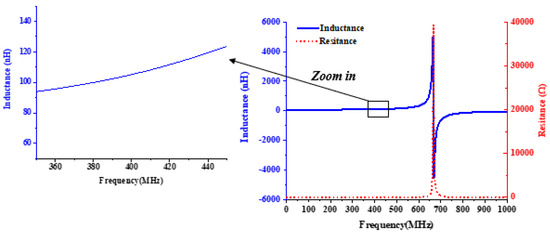
Figure 2.
Simulated inductance and resistance of the conventional rectangular PSC.
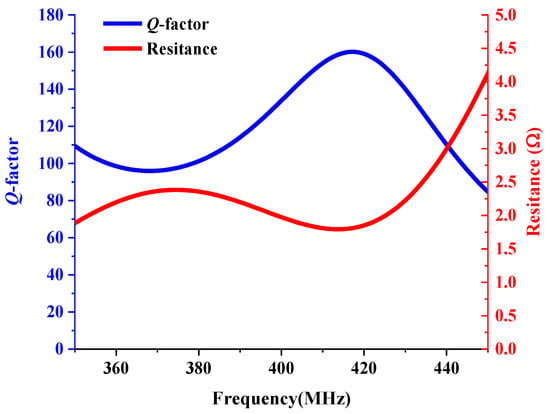
Figure 3.
Simulated Q-factor and resistance of the optimised rectangular PSC.
2.2. A Planar Split-Ring Loop
Now that the general split-ring loop design is shown to significantly reduce resistance and increase the Q-factor, the aim is to increase the loop inductance again to match that of the rectangular PSC in [14], so that the effect of increasing the Q-factor on PTE can be seen directly. The increase in inductance is achieved by increasing the number of split-ring turns. The current direction is opposite between two adject traces of the split-ring loop, which can decrease the effect of current crowding caused by eddy currents. That decreased the resistance of the split-ring loop, resulting in the increase in Q-factor. A new design with four turns is shown in Figure 4. The inner radius of the design is set at 1 mm. Design parameters have been swept with the aim of matching the inductance of the rectangular PSC (106 nH) [14] at the design frequency.
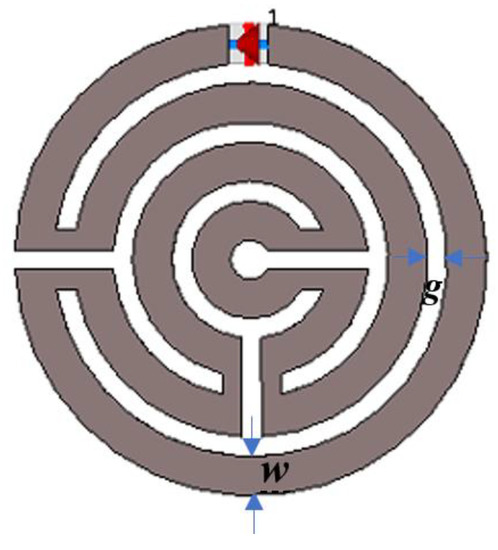
Figure 4.
Geometric schematic of four-turn split-ring loop.
The width of four-turn split-ring loop (parameter w) has been varied from 2 mm to 5 mm in a step of 1 mm (with the gap g = 1 mm). The gap between traces of four-turn split-ring loop (parameter g) has been varied from 0.5 mm to 2 mm in a step of 0.5 mm (with the width w = 2 mm). The inductance obtained for each sweep is shown in Figure 5.
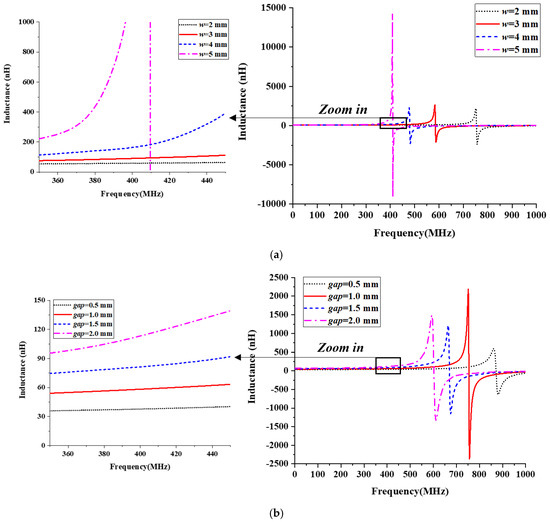
Figure 5.
Simulated inductance of four-turn split-ring loops with (a) swept parameter w (with the gap g = 1 mm); (b) swept parameter g (with the width w = 2 mm).
From Figure 5, the self-resonance frequency of the design decreases as either parameter w or parameter g increases. For all parameter values observed the loop presents as inductive at 403 MHz. Only when parameter w is 3 mm is the inductance of this design close to that of the rectangular PSC at 403 MHz, 106 nH.
To obtain an inductance closer to 106 nH, a parametric study including w1, w2, w3, w4, g1, g2 and g3) has been further investigated. The geometric layout model of this proposed four-turn split-ring loop is illustrated in Figure 6. The split-ring loop is printed on 1.5 mm FR-4 substrate with an area of 45 mm × 45 mm. Details of the final parameters are provided in Table 2. The parametric study was made by means of full-wave simulations performed using the transient solver of Computer Simulation Technology (CST) Microwave Studio.
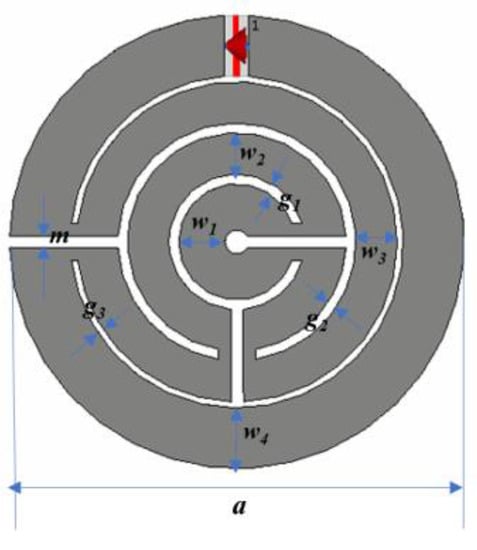
Figure 6.
Geometric layout model of the optimised four-turn split-ring loop.

Table 2.
Final dimensions of the proposed split-ring loop.
From Figure 7 and Figure 8, the self-resonance frequency is around 500 MHz and the inductance and resistance at 403 MHz are 103 nH and 0.16 Ω, respectively. The Q-factor of this loop is 1630 at 403 MHz, which is 11 times greater than that of the rectangular PSC.
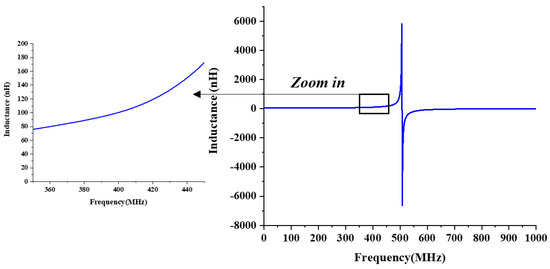
Figure 7.
Simulated inductance of the optimised four-turn split-ring loop.
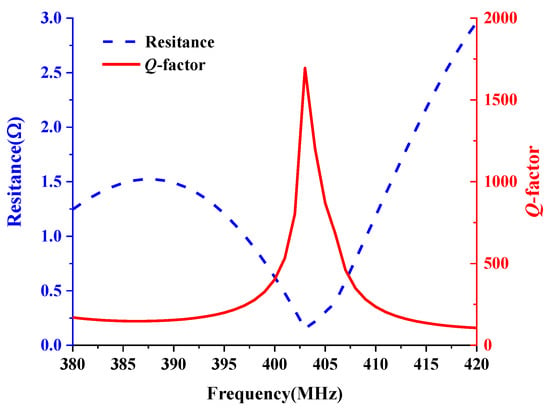
Figure 8.
Simulated parasitic resistance and Q-factor of the optimised four-turn split-ring loop.
3. Performance of the WPT Link Using Planar Split-Ring Loop
To investigate the performance of a wireless power link between two of the proposed four-turn planar split-ring loops, two compensation capacitors are necessary to match the WPT circuit between source and load. As series-parallel (SP) topology of MRC-WPT is suitable for the larger load [18], the SP topology for MRC-WPT is used, as shown in Figure 9. Inductors (L1 and L2) represent two identical split-ring loops. Parasitic resistance and capacitance are considered negligible in this case for the simplicity of simulation and measurement. Capacitors (C1 and C2) are chosen to be 1.52 pF to obtain a resonance frequency of 403 MHz based on Equation (1). Us represents the voltage source with the sine input-signal. Rsc and RL represent the source resistance and the load impedance of 1 kΩ, respectively. The WPT circuit can be constructed in the schematic of CST allowing the performance of the WPT link to be simulated.
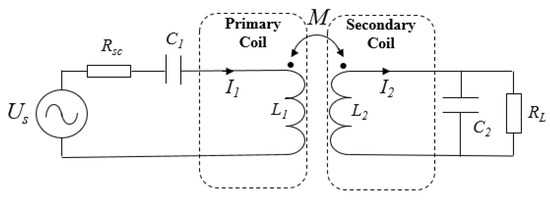
Figure 9.
Equivalent WPT circuit by using four-turn split-ring loops.
An overview of the transmit and receive loops is shown in Figure 10 and the transfer distance (d) between the loops is varied as 5 mm, 10 mm, 15 mm, 20 mm, 25 mm and 30 mm. The trends of PTE at different transfer distances are depicted in Figure 11.
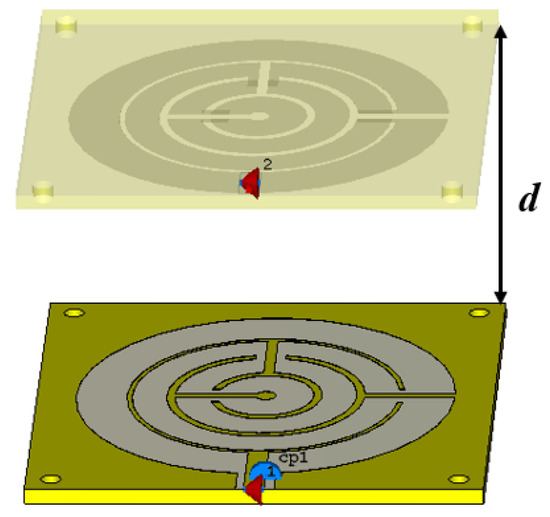
Figure 10.
Schematic of wireless power link with proposed four-turn split-ring loops.
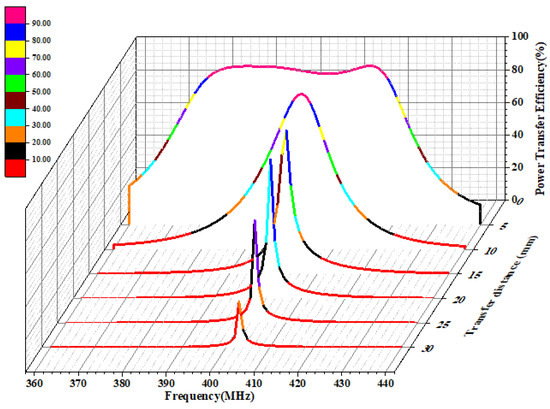
Figure 11.
Simulated PTE at different transfer distance by using four-turn planar split-ring loops.
It can be seen from Figure 11 that the PTE at the resonance frequency of 403 MHz decreases as the transfer distance enlarges. At a transfer distance of 5 mm, the PTE is over 90% from 377 MHz to 419 MHz since the magnitude of the equivalent input impedance is close to 50 Ω (source impedance) over this range. However, the resonance frequency, where the imaginary part of the input impedance is equal to zero, is not 403 MHz, which means the transfer distance of 5 mm is not the optimal transfer distance. As the transfer distance becomes larger, only one resonance frequency appears, located at 403 MHz, where the PTE reaches its peak. The maximum PTE is 95.3% at a transfer distance of 10 mm and then decreases dramatically to 28% at a transfer distance of 30 mm. Importantly, the PTE is 85.1% at a transfer distance of 20 mm, which is similar to that WPT link using conventional rectangular PSCs at a transfer distance of 5 mm. This means the performance of the WPT link with four-turn planar split-ring loops can operate over a larger distance with the same efficiency, due to the significantly improved Q-factor. However, it is also important to highlight that the operating bandwidth is narrower than that of the conventional rectangular PSC again as a result of the increased Q-factor. Therefore, there exists a trade-off between bandwidth and power transfer distance through manipulation of the Q-factor. The comparison between this proposed split-ring loop and the conventional rectangular PSC is summarised in Table 3.

Table 3.
The comparison between this proposed split-ring loop and the conventional rectangular PSC.
4. Measurement
The proposed wireless power link was fabricated on FR-4 substrate as shown in Figure 12 using a PCB milling machine. The transmitting split-ring loop with a series chip capacitor (1.52 pF) is directly soldered with a subminiature version A (SMA) connector. This is connected to an RF signal generator via a circulator to mitigate reflection loss. The receiving split-ring loop with parallel chip capacitor (1.52 pF) and parallel chip resistor (1 kΩ load) is soldered directly to copper wire, to allow direct connection to the probe of an RF oscilloscope. The holes at the corners of the substrate are to allow for plastic support fixtures to hold the boards in place during measurement. The measurement setup can be seen in Figure 13. The separation of the wireless power link is 20 mm.
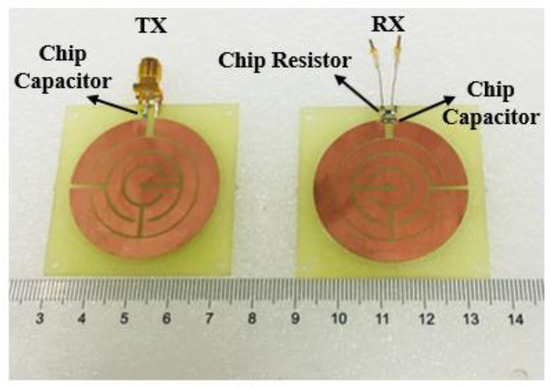
Figure 12.
Fabricated wireless power link with proposed four-turn split-ring loops.
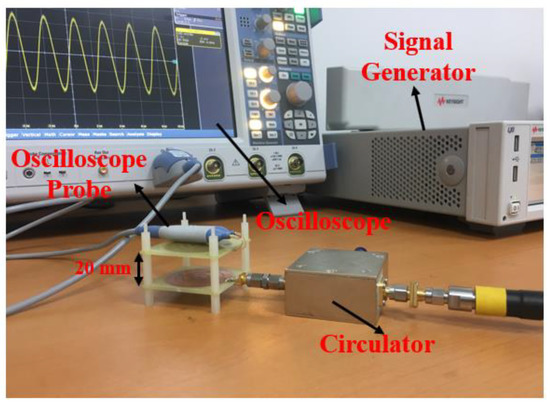
Figure 13.
Measurement setup of wireless power link with proposed four-turn split-ring loops.
The used RF signal generator from Keysight was set to 0 dBm (1 mW) and varied over the frequency range 385 MHz~420 MHz. The output voltage across the load was measured using the RF oscilloscope in 1 MHz increments. PTE could then be calculated using the root-mean-square (RMS) of the voltage across the load (VL) and input power as expressed in Equation (2).
The measured PTE against frequency is shown in Figure 14. It can be seen that the measured PTE reaches a peak of 80.5% at a transfer distance of 20 mm when the resonance frequency is 403 MHz. The power loss between signal generator and the primary circuit and the decreased mutual inductance caused by the practical environment, results in the measured PTE being lower than the simulated PTE.
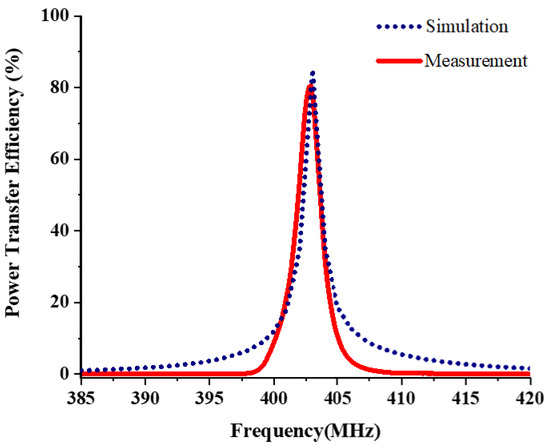
Figure 14.
Comparisons of simulated and measured PTE against frequency.
The measured PTE at 403 MHz over different transfer distances is shown in Figure 15. It is clear to see that the measured PTE remains stable between 5 mm and 10 mm and then decreases from 89% to 25% as the transfer distance increases to 30 mm, which is similar to the simulated results.
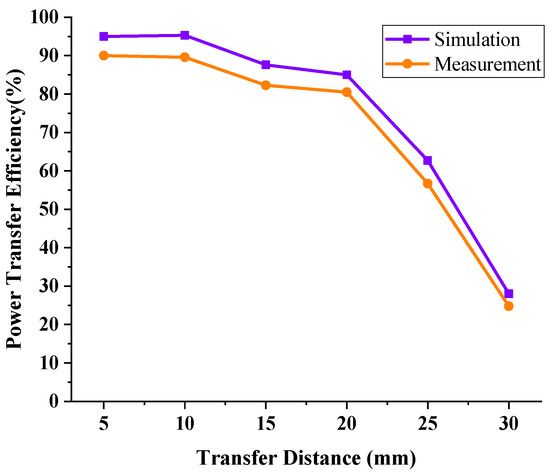
Figure 15.
Simulated and measured PTEs of the WPT link with four-turn split-ring loops at different transfer distances.
The measured PTE shows good agreement with the simulated PTE and shows that the proposed four-turn split-ring loop offers better performance for a WPT link than a conventional rectangular PSC. Comparisons of this design with other works are shown in Table 4.

Table 4.
The comparison between this proposed split-ring loop and the conventional rectangular PSC.
5. Conclusions
A four-turn split-ring loop was proposed in this work to increase the Q-factor by decreasing ohmic loss. To form series and parallel resonators at the desired frequency (403 MHz) from the transmit and receive loops, series and parallel lumped capacitors with the capacitance of 1.5 pF had to be added, respectively. With an improved Q-factor of 1630 (from 140), the PTE of this proposed WPT link reached 83% at a transfer distance of 20 mm.
Author Contributions
Conceptualization, J.W.; methodology, J.W., M.P.L., E.G.L., Z.W. and Y.H.; software, J.W.; validation, J.W., R.P. and Z.J.; formal analysis, J.W., M.P.L., E.G.L. and Z.W.; investigation, J.W.; resources, J.W.; data curation, J.W.; writing—original draft preparation, J.W.; writing—review and editing, M.P.L., E.G.L., Z.W. and Y.H.; visualization, J.W.; supervision, M.P.L., E.G.L., Z.W. and Y.H.; project administration, E.G.L.; funding acquisition, M.P.L., E.G.L. and Z.W. All authors have read and agreed to the published version of the manuscript.
Funding
This research was partially funded by the AI University Research Centre (AI-URC), Jiangsu (Provincial) Data Science and Cognitive Computational Engineering Research Centre at Xi’an Jiaotong-Liverpool University (XJTLU) and XJTLU Key Programme Special Fund (KSF-P-02) and XJTLU Research Development Fund (PGRS-13-03-06, RDF-14-03-24, RDF-14-02-48, PGRS-2006007 and PGRS-2012013).
Institutional Review Board Statement
Not applicable.
Informed Consent Statement
Not applicable.
Data Availability Statement
Data Availability Statements in section “MDPI Research Data Policies” at https://www.mdpi.com/ethics (accessed on 1 September 2021).
Acknowledgments
The authors would like to express their sincere gratitude to CST AG for providing the CST STUDIO SUITE® electromagnetic simulation software package under the China Key University Promotion Program, and Suzhou Municipal Key Lab for Wireless Broadband Access Technologies in the Department of Electrical and Electronics Engineering, Xi’an Jiaotong-Liverpool University, for research facilities.
Conflicts of Interest
The authors declare no conflict of interest.
References
- Jiang, Z.; Wang, Z.; Leach, M.; Lim, E.G.; Wang, J.; Pei, R.; Huang, Y. Wideband Loop Antenna with Split-Ring Resonators for Wireless Medical Telemetry. IEEE Antennas Wirel. Propag. Lett. 2019, 18, 1415–1419. [Google Scholar] [CrossRef]
- Wang, J.; Lim, E.G.; Leach, M.; Wang, Z.; Man, K.L.; Huang, Y. Review of Wearable Antennas for WBAN Applications. IAENG Int. J. Comput. Sci. 2016, 43, 474–480. [Google Scholar]
- Lim, E.; Wang, Z.; Yu, F.Z.; Tillo, T.; Man, K.L.; Wang, J.C.; Zhang, M. Transmitter antennas for wireless capsule endoscopy. In Proceedings of the 2012 International SoC Design Conference (ISOCC), Jeju, Korea, 4–7 November 2012; pp. 269–272. [Google Scholar]
- Dinis, H.; Colmiais, I.; Mendes, P.M. Extending the Limits of Wireless Power Transfer to Miniaturized Implantable Electronic Devices. Micromachines 2017, 8, 359. [Google Scholar] [CrossRef] [PubMed] [Green Version]
- Hui, S.Y.R. Planar Wireless Charging Technology for Portable Electronic Products and Qi. Proc. IEEE 2013, 101, 1290–1301. [Google Scholar] [CrossRef] [Green Version]
- Popovic, Z. Cut the Cord: Low-Power Far-Field Wireless Powering. IEEE Microw. Mag. 2013, 14, 55–62. [Google Scholar] [CrossRef]
- Ho, S.L.; Wang, J.; Fu, W.; Sun, M. A Comparative Study Between Novel Witricity and Traditional Inductive Magnetic Coupling in Wireless Charging. IEEE Trans. Magn. 2011, 47, 1522–1525. [Google Scholar] [CrossRef]
- Kurs, A.; Karalis, A.; Moffatt, R.; Joannopoulos, J.D.; Fisher, P.; Soljačic, M. Wireless Power Transfer via Strongly Coupled Magnetic Resonances. Science 2007, 317, 83–86. [Google Scholar] [CrossRef] [PubMed] [Green Version]
- Lu, F.; Zhang, H.; Mi, C. A Review on the Recent Development of Capacitive Wireless Power Transfer Technology. Energies 2017, 10, 1752. [Google Scholar] [CrossRef] [Green Version]
- Khan, S.R.; Choi, G. Analysis and Optimization of Four-Coil Planar Magnetically Coupled Printed Spiral Resonators. Sensors 2016, 16, 1219. [Google Scholar] [CrossRef] [PubMed] [Green Version]
- Jolani, F.; Yu, Y.; Chen, Z. A Planar Magnetically Coupled Resonant Wireless Power Transfer System Using Printed Spiral Coils. IEEE Antennas Wirel. Propag. Lett. 2014, 13, 1648–1651. [Google Scholar] [CrossRef]
- Falavarjani, M.M.; Shahabadi, M.; Rashed-Mohassel, J. Design and Implementation of Compact WPT link using Printed Spiral Resonators. Electron. Lett. 2014, 50, 110–111. [Google Scholar] [CrossRef]
- Mehri, S.; Ammari, A.C.; Slama, J.B.H.; Rmili, H. Geometry Optimization Approaches of Inductively Coupled Printed Spiral Coils for Remote Powering of Implantable Biomedical Sensors. J. Sens. 2016, 2016, 4869571. [Google Scholar] [CrossRef]
- Wang, J.; Leach, M.; Lim, E.; Wang, Z.; Huang, Y. Wireless Power Transfer Using Resonance Coupling Method for Implantable Applications. In Proceedings of the 2018 IEEE International Symposium on Antennas and Propagation & USNC/URSI National Radio Science Meeting, Boston, MA, USA, 8–13 July 2018; pp. 2557–2558. [Google Scholar]
- Javidi, F.N.; Nymand, M. A New Method for Measuring Winding AC Resistance of High-Efficiency Power Inductors. IEEE Trans. Power Electron. 2018, 33, 10736–10747. [Google Scholar] [CrossRef]
- Sathyasree, J.; Vanukuru, V.; Nair, D.; Chakravorty, A. Compact Modeling of Proximity Effect in High-Q Tapered Spiral Inductors. IEEE Electron Device Lett. 2018, 39, 588–590. [Google Scholar] [CrossRef]
- Lawson, J.; Yates, D.C.; Mitcheson, P.D. High Q Coil Measurement for Inductive Power Transfer. IEEE Trans. Microw. Theory Tech. 2019, 67, 1962–1973. [Google Scholar] [CrossRef]
- Wang, J.; Leach, M.; Lim, E.; Wang, Z.; Huang, Y. Investigation of magnetic resonance coupling circuit topologies for wireless power transmission. Microw. Opt. Technol. Lett. 2019, 61, 1755–1763. [Google Scholar] [CrossRef]
- Duan, Z.; Guo, Y.; Kwong, D.-L. Rectangular coils optimization for wireless power transmission. Radio Sci. 2012, 47, RS2013. [Google Scholar] [CrossRef]
- Kim, S.; Bae, B.; Kong, S.; Jung, D.H.; Kim, J.J.; Kim, J. Design, implementation and measurement of board-to-board wireless power transfer (WPT) for low voltage applications. In Proceedings of the 2013 IEEE 22nd Conference on Electrical Performance of Electronic Packaging and Systems, Austin, TX, USA, 27–13 October 2013; pp. 91–95. [Google Scholar]
- Wang, J.; Leach, M.P.; Lim, E.; Wang, Z.; Jiang, Z.; Pei, R.; Huang, Y. A Conformal Split-Ring Loop as a Self-Resonator for Wireless Power Transfer. IEEE Access 2019, 8, 911–919. [Google Scholar] [CrossRef]
Publisher’s Note: MDPI stays neutral with regard to jurisdictional claims in published maps and institutional affiliations. |
© 2021 by the authors. Licensee MDPI, Basel, Switzerland. This article is an open access article distributed under the terms and conditions of the Creative Commons Attribution (CC BY) license (https://creativecommons.org/licenses/by/4.0/).